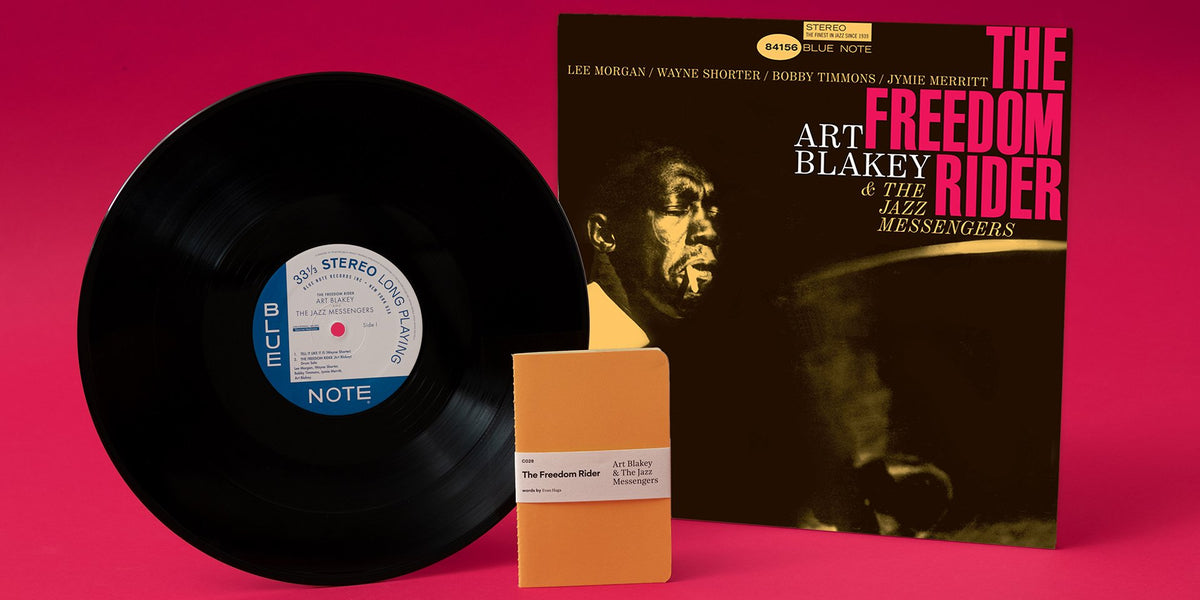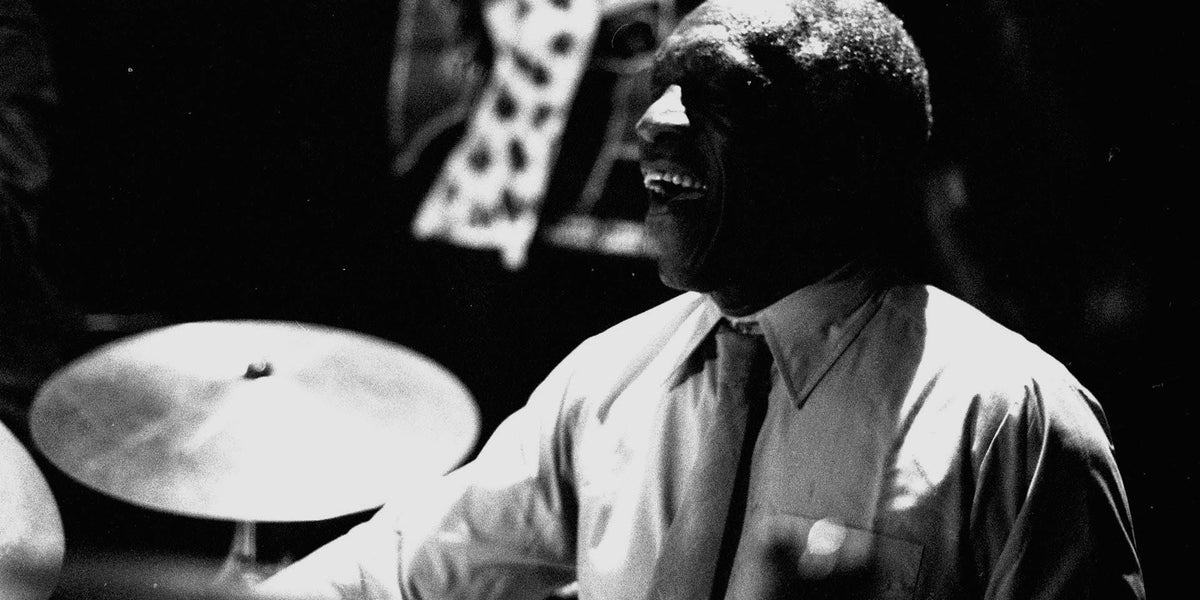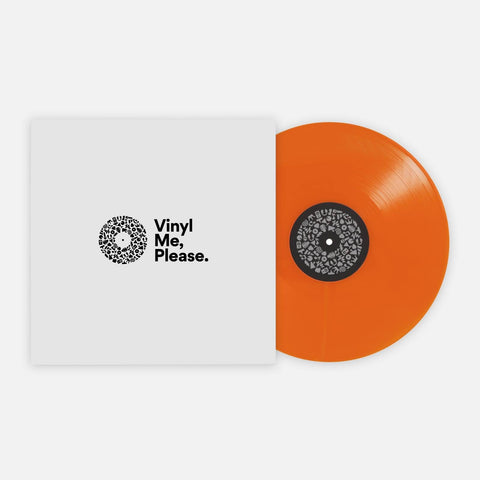Art Blakey’s Civil Rights Jazz
Read The Liner Notes For Our New Edition Of ‘The Freedom Rider’
On May 27, 1961, Art Blakey sat down at the drumkit in his second home of sorts, the most important recording studio in jazz history, engineer Rudy Van Gelder’s high-ceilinged marvel in Englewood Cliffs, New Jersey. After a spirited shuffle through a blues by Wayne Shorter, joined by one of jazz’s hall-of-fame working groups — Shorter, tenor saxophone; Lee Morgan, trumpet; Bobby Timmons, piano; Jymie Merritt, bass — Blakey started in on a suite-like, seven-and-a-half-minute drum solo. Throughout what would become “The Freedom Rider,” the title track to an undervalued LP for Blue Note Records, he keeps time for himself with a signature covert snip of the hi-hat. That bedrock in place, Blakey tells the remainder of his story with surging rolls and dynamic patterns and agitated crashes that combine to underscore a triptych of influences: swing-era drum heroes like Big Sid Catlett and Chick Webb, the percussive traditions of Latin America, and the African rhythms he absorbed during his time on the continent in the late ’40s.
If what musicians and critics call polyrhythmic can be defined as drumming that grants the kit the dimensions of an orchestra, then “The Freedom Rider” should be considered Blakey’s pièce de résistance. As his pioneering drum colleague Max Roach told the New York Times in 1990, following Blakey’s death at age 71, “Art was the perhaps the best at maintaining independence with all four limbs. He was doing it before anybody was.”
With this solo tour de force, Blakey steps onto conceptual terrain. It places him in a tradition of drummers brave enough to track sans accompaniment, a lineage including Footnotes to Jazz, Vol. 1: Baby Dodds Talking and Drum Solos, Roach’s Drums Unlimited, Tony Williams’ “Some Hip Drum Shit,” Paul Motian’s “Ch’i Energie” and more. Its title, invoking a civil-rights gambit still in progress when the work was recorded, positions it under the banner of jazz-as-protest, a heritage that begins with the genre’s African-African work-song roots and continues through every stage of its development. (A list of related recordings could pack out the remainder of this space, but to name a few: Louis Armstrong’s “Black and Blue,” Billie Holiday’s “Strange Fruit,” Sonny Rollins’ Freedom Suite, We Insist!, Max Roach’s Freedom Now Suite, John Coltrane’s “Alabama,” Mingus’ “Fables of Faubus,” Archie Shepp’s Attica Blues, and “Malcolm, Malcolm—Semper Malcolm,” Nina Simone’s “Mississippi Goddam,” the music of Gary Bartz’s NTU Troop, Christian Scott aTunde Adjuah’s “K.K.P.D.” …)
The majority of The Freedom Rider was captured on that May date, the quintet’s final studio session, toward the close of a month that stands among the most crucial in the timeline of the American Civil Rights Movement. Following decisions including 1960’s Boynton v. Virginia and 1946’s Morgan v. Virginia, the Supreme Court had guaranteed as federal law that segregation on commercial interstate buses and in interstate terminal restaurants and facilities was unconstitutional. But many Southern states, still in the throes of Jim Crow and under the rule of white segregationists, refused to enforce these decisions. On May 4, seven African-American and six white activists boarded public buses in Washington, D.C., bound for Louisiana. These Freedom Rides, which would travel deeper into the South than a previous effort in the ’40s, provoked horrendous violence over the ensuing summer and fall but also gained hundreds of participants and countless supporters across the nation. Built upon a strategy of nonviolent protest, the movement garnered tremendous media coverage that generated new legislation and orders of enforcement.
Still, rosy retrospection should never underestimate the peril the Freedom Riders faced down. On Mother’s Day, May 14, a throng including Klansmen who were abetted by the police attacked the Riders in Anniston, Alabama, and firebombed one of the buses. More mob violence followed in Birmingham and Montgomery. In the latter town, after the Nashville Student Movement had formed the cause’s second generation, thousands of segregationists rioted outside of a Baptist church hosting a tribute to the Riders that included Martin Luther King. On May 24, just three days before Blakey would record his solo, Riders were arrested in Jackson, Mississippi, after attempting to use whites-only facilities. Abiding by the movement’s “Jail No Bail” mantra, hundreds of Riders eventually occupied the notorious Parchman Farm.
Blakey certainly had good reason to support the Riders via his four-limbed homage. An orphan from Pittsburgh, he cut his teeth early on as a pianist but had switched to drums in time for professional experience with Mary Lou Williams and Fletcher Henderson’s band. In the early to mid-’40s, while on the road with Henderson in Georgia, he was beaten by police in a race-related incident — so viciously, in fact, that surgery was necessary and a steel plate was placed in the drummer’s head. He retreated north, to a steady gig in Boston. Later that decade, during his transformative journey to Africa, Blakey would become immersed in Islam and take on the moniker Abdullah Ibn Buhaina, which yielded his nickname Bu.
Listening back to Blakey’s soliloquy with this context brings on a tide of evocations: the cycling Greyhound and Trailways tires in those tom and snare rolls; the taunts and tossed rocks and other acts of hate in those single strokes and cymbal crashes; those moments when anxiety became action, represented by Blakey’s shifts from single drums to an Afro-Cuban-ish groove spread throughout the kit. And, at various points, the uncertainty that comes with stillness. More than anything, however, “The Freedom Rider” is an exercise in resilience. As Nat Hentoff wrote in the LP’s original notes: “[A]rt Blakey conjures up the whirlpool of emotions at that time — the winds of change sweeping the country, the resistance to that change, and the pervasive conviction of the Freedom Riders that ‘We Shall Not Be Moved.’”
It’s possible to speak about Art Blakey as one of jazz’s monumental figures without mentioning the drums. You might talk about how few artists have represented a record label with the kind of ambassadorship that defined Blakey’s relationship with Blue Note. Although he recorded for many labels in his career, Blakey steered some of Blue Note’s finest bands and contributed a stack of its best-loved recordings as a leader and sideman. In the process, he designed the label’s first signature sound, the more patient, blues-soaked bop derivation called hard bop.
He also nurtured generations of major-league jazz musicians through his ever-shifting working group, the Jazz Messengers, where he encouraged his young musicians to write, just as he urged them to lead their own bands after they left. The chronology of the Jazz Messengers is a labyrinth of one worthy lineup tweak after the next, but its proper story begins in the ’50s, when Blakey began guiding a potently swinging, gospel-infused collective with the pianist Horace Silver. After his break with Silver, the drummer helmed a robust quintet, highlighted by Jackie McLean on alto saxophone, that worked fruitfully until 1958, when it dissolved and Blakey tapped Morgan, Timmons, Merritt and the tenorman Benny Golson, young masters who’d developed on the Philadelphia scene. In October of ’58, this lineup recorded Moanin’, which, touting a few future standards — Timmons’ title cut, Golson’s “Blues March” and “Along Came Betty” — became Blakey’s (and arguably Blue Note’s) flagship album. Its “The Drum Thunder Suite” features rhythmic language that was distilled further on “The Freedom Rider.”
Golson would split and form the Jazztet in 1959 with trumpeter Art Farmer. The saxophonist’s replacement, Hank Mobley, missed a gig at a Canadian festival, presenting Morgan with an opportunity to convince Blakey to hire his brilliant friend, Wayne Shorter, a recently discharged army man who was also appearing at the fest, in trumpeter Maynard Ferguson’s big band. Introductions were made, and not long after, Blakey placed a soothsaying call to Ferguson: “Wayne is a fighter pilot stuck in a big band!” he said. Shorter was relieved of his duties.
In Shorter, 27 at the time The Freedom Rider was recorded, Blakey, then 41, employed perhaps the most influential jazz composer ever at the outset of his sly innovations. Working toward his heady mid-’60s, Shorter had begun personalizing the staple harmonic and formal elements of jazz composition, and the resultant music still gives off a weird, wonderful, funhouse-mirror effect, like hearing blues and bop in a reverie. His saxophone playing followed suit, in its effective blend of tonal and technical wonders with his willingness to sidestep easy harmonic answers. For his part, Morgan, 22, could probe and explore but also embodied the role of the consummate hard bopper, both as a writer and a player; his tunes and solos were pure bop-centered charisma, crafted and delivered with flawless rhythmic panache and no more virtuosity than was needed. Merritt, 35, had the innate sense of groove that allowed him to drop anchor next to Blakey, plus a lithe touch and theoretical know-how accrued in classical studies. Timmons, 25, despite his pigeonholed legacy as an R&B fan’s kind of jazzer and the composer of “Moanin’,” was a sage pianist right at home inside Shorter’s modernism.
This incarnation of Art Blakey and the Jazz Messengers gigged prolifically and spent seven days in the studio between March of 1960 and May of 1961, in addition to a live record date at Birdland in September of 1960. Over the years that embarrassment of riches has fed many Blue Note LPs, expanded reissues and box sets. The Freedom Rider was released in 1964, and aside from the title cut, its original pressing included two tunes apiece by Shorter and Morgan.
Shorter’s “Tell It Like It Is” is a headstrong shuffle-blues and an opportunity to hear Blakey have one hell of a good time leading his band. “Blow your horn!” he hollers at Morgan. “Tell it like it is!” he encourages Timmons, before reminding Merritt to “Walk! Walk! Walk! Walk!” “Alright!” he shouts as Shorter and Morgan re-enter with the theme — and how delightful it is to hear the saxophonist on a time-honored form, engaging in a stout and straightforward frontline kinship.
“El Toro,” another Shorter composition, is a 16-bar line with Latin ambiance, and it inches toward the furtive curveballs that would become his trademark. But mostly it’s a mid-to-uptempo swinger with fantastic blowing, not least from the saxophonist, who burns in Coltrane fashion during his opening solo, offering rapid-fire rising and falling lines that dive bomb toward low honks. Pushing beyond his bluesy rep, Timmons reveals more of his bop learning, and Blakey customizes the pianist’s accompaniment with snare and rim accents. (Listening closely to Blakey interact with and play to the soloist is always pure pleasure; also notice how seamlessly he shifts from groove to swing during this head.) Morgan, who trades eights with Shorter at the finish, proves in his choruses here and elsewhere that he used the trumpet’s high notes with more intelligence than pretty much anyone. For him, those alpine pitches were about lyricism and storytelling rather than ego.
The trumpeter’s two contributions guarantee The Freedom Rider’s sanctified rapture. As if cutting the dramatic intensity of the title cut and the stealthy smarts of “El Toro,” Morgan’s “Petty Larceny” is undeniable barroom jazz, an easy-shuffling blues with a hip melodic echo in the theme, spacious blowing and a nimble solo by Merritt. (It’s also the lone cut included here from the band’s February 18, 1961, session.) To close, “Blue Lace” swings in waltz time with strength but also impressive sensitivity.
Shorter would remain with Blakey until 1964, the same year he began changing jazz’s trajectory as a writer and player in Miles Davis’ Second Great Quintet. As a bandleader on Blue Note in ’64, he recorded three albums, Night Dreamer, JuJu, and Speak No Evil, that remain totems of the artful bebop branch called postbop. Morgan left the Messengers in 1961 and was replaced by the fearsomely virtuosic Freddie Hubbard, though he’d later return to Blakey’s fold. He created his own canon, mostly on Blue Note — LPs including The Sidewinder and, with Shorter, Search for the New Land — and died violently in 1972, gunned down by his common-law wife at the East Village haunt Slugs’ Saloon. Morgan was 33. Timmons also died young, in 1974 at 38 and, sadly, of cirrhosis brought on by substance abuse. Merritt, now in his 90’s, can reflect on gigs and sessions with Blakey, Roach, Golson, B.B. King, Sonny Clark and Chet Baker, in addition to his groundbreaking early use of the electric bass and his community-building efforts in Philadelphia.
Blakey would continue living his epic life of tutelage. At the time of this writing, the official website of the Art Blakey estate includes a list of 217 Messengers alumni, and it reads like a roadmap to the story of jazz in total. The ’50s and ’60s saw names like Golson, Hubbard, Mobley, McLean, Clifford Brown, Kenny Dorham, Johnny Griffin, Woody Shaw, and Cedar Walton join his camp. In the ’80s, Blakey taught the tenets of swing to a generation of impassioned, marketable men who would become known as the Young Lions: Wynton and Branford Marsalis, Terence Blanchard, Wallace Roney, Donald Harrison Jr., Kenny Garrett, Benny Green and more. Still, he never fostered another small group as gifted and auspicious as the one he reared in 1960 and ’61.
Evan Haga worked as an editor and writer at JazzTimes from 2006 to 2018. During his tenure, the magazine won three ASCAP Deems Taylor Awards, one of which was for an article Haga wrote on the confluence of jazz and heavy metal. He is currently the Jazz Curator at TIDAL, and his writing has appeared at RollingStone.com, NPR Music, Billboard.com and other outlets.
Related Articles
Join the Club!
Join Now, Starting at $36Pages







